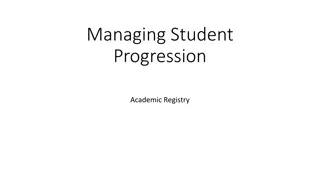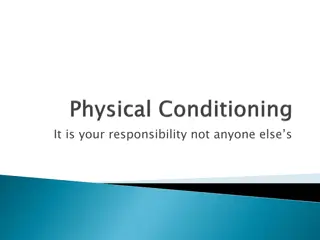Principles of Training: Overload, Specificity, and Progression
Principles of training encompass overload, specificity, and progression. Overload requires doing more than usual, specificity involves tailored activities, and progression ensures gradual advancement. These principles are vital for improving fitness levels safely and effectively, emphasizing the need to increase activity levels gradually and engage in exercises specific to desired goals. The F.I.T.T. principle highlights variables for achieving overload, such as intensity, frequency, and time. By understanding and applying these principles, individuals can optimize their workout routines and enhance overall physical fitness.
Download Presentation

Please find below an Image/Link to download the presentation.
The content on the website is provided AS IS for your information and personal use only. It may not be sold, licensed, or shared on other websites without obtaining consent from the author.If you encounter any issues during the download, it is possible that the publisher has removed the file from their server.
You are allowed to download the files provided on this website for personal or commercial use, subject to the condition that they are used lawfully. All files are the property of their respective owners.
The content on the website is provided AS IS for your information and personal use only. It may not be sold, licensed, or shared on other websites without obtaining consent from the author.
E N D
Presentation Transcript
PRINCIPLES OF TRAINING OVERLOAD You do more than you normally do You do activities specific to your activity. SPECIFICITY You gradually increase your activity level. PROGRESSION OVERLOAD, SPECIFICITY AND PROGRESSION ARE NOT THE SAME AS FREQUENCY, INTENSITY AND TIME
When you leave, you will know How the Principle of Overload increases your fitness levels In what 3 ways is overload accomplished Why is it important for you to progress at a safe rate in your exercise Program What principle would you apply if you wished to improve a specific muscle
What is Overload? You do more than you normally do, not something new Example: If you play Basketball every day at lunch for 10 minutes, then you would overload by playing basketball everyday for 20 minutes
OVERLOAD MAY BE ACCOMPLISHED BY INCREASING ONE OF THE 3 VARIABLES OF THE F.I.T.T PRINCIPLE How long you exercise T Intensity How hard you exercise I F Frequency How often you exercise
1st known example of OVERLOAD MILO OF CROTONA He lifted a small calf several times a week. The calf grew heavier and heavier Milo s muscles grew stronger, allowing him to lift more and more weight.
PRINCIPLE OF PROGRESSION Point 3 Point 1 Point 2 Slowly apply stress to the body, bones and muscles If you exercise too intensely or too long, you may feel very tired, have nausea or vomit, and muscle joint aches and pains do not go away quickly Increase progression slowly, especially at the beginning of a workout program
PRINCIPLE OF SPECIFICITY SPECIFIC EXERCISES THAT IMPROVE SPECIFIC COMPONENTS OF PHYSICAL FITNESS IN SPECIFIC AREAS Examples: Flexibility exercises will help with Gymnastics, but will not improve Cardiorespiratory endurance. If you train for Gymnastics and then try to play Basketball, you become easily fatigued or tired.
When you start an exercise program, you should do Check your beginning fitness levels and use that as a foundation so you can see your improvement Check with your doctor regarding your health
If your fitness levels are low, what can you do? Look at overloading your exercise routine. Increase the frequency, intensity and/or time of your workouts Slowly and gradually increase your workouts Do activities that relate directly to your activity. For example: If you want to get better at Soccer, you will do more Cardiorespiratory activities and agility drills with soccer ball rather than hitting a baseball or throwing a football
What is Reversibility? If you stop exercising or using your muscles, they will become weak. You will have to start all over If you don t use it, you will lose it
What does Tedious mean? To do the same activity or chore every single day. If you do the same exercise each time you work out, your muscles will plateau and never get stronger. You need a variety to activities to keep your muscles energized. Example, if you ride your bike to help improve your Cardiorespiratory system, then include walking, running, swimming, jump rope or other aerobic activities to keep your muscles at peak performance
REVIEW OF PRINCIPLES OF TRAINING SPECIFICITY OVERLOAD PROGRESSION Put stress on your muscles, joints and bones so they become stronger and function better- Do specific exercises that improve a specific activity The body adapts to the exercise it does, so you need to slowly increase the amount of exercise in order for it to become stronger ** Example: Flexibility will help with Gymnastics **Use Frequency, Intensity and Time ** Example: Shooting Baskets will help with Basketball.
Thought Questions How does the Principle of Overload increase your fitness levels? It exposes the muscles, joints and Cardiorespiratory systems to more work and stress than is normally experienced
Thought Questions In what 3 ways is overload accomplished? 1. INCREASE FREQUENCY (THE NUMBER OF TIMES YOU EXERCISE) 2. INCREASE TIME (HOW LONG YOU EXERCISE) 3. INCREASE INTENSITY (HOW HARD YOU EXERCISE)
Thought Questions Why is it important for you to progress at a safe rate in your exercise program? So you don t get really tired during your workout Don t injure your muscles and joints Don t get nauseated or vomit before/after exercise As you exercise harder, your body adapts. You must slowly train your muscles for the increased workload
Thought Questions What principle would you apply if you wished to improve a specific muscle?























